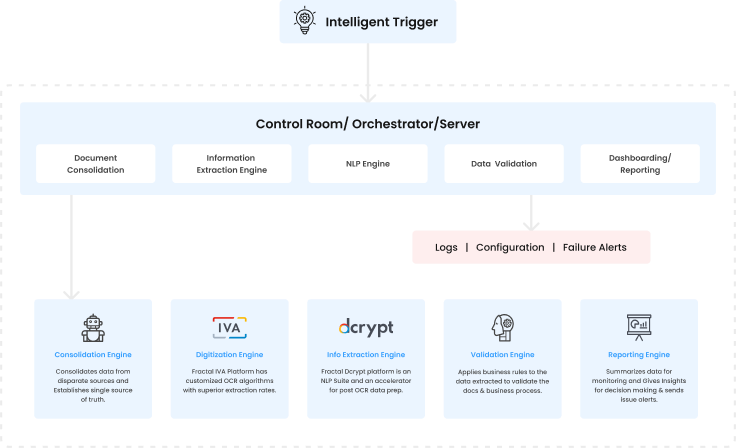Overview
Document digitization is fast becoming vital in streamlining business processes. Principal architect Ritesh Thakur, Senior Data Scientist Sarveshwaran Jayaraman, and Architect Akash Gupta guide readers through its requirements, challenges, and exciting possibilities.
Comprehensive data about customers, vendors, and entities must be collected and maintained for businesses to succeed in their operations, including financial and human resources information. However, transforming this data from traditional physical documents into structured data sets requires significant manual effort. Recent advancements in machine vision and natural language processing(NLP) have produced automated solutions that reduce manual efforts in digitization.
Despite these advances, several challenges remain. From a business perspective, multiple touchpoints can result in data inconsistencies and processing delays. Managing diversity — different documents that have the same purpose, for example also poses a significant hurdle. From a systems perspective, technology should be deployed judiciously to ensure that it doesn’t negatively impact a process’s efficiency and effectiveness. Before translating physical documents into digital data, careful consideration needs to be given to the who,why, what, and when of digitization.
What should be digitized — and when?
Most document digitization solutions focus on situations where the data is being consumed and used in the present day. While these documents may not be critical for decision-making per se, they are important for operational efficiency and the simplification of processes.
While document digitization falls within an organization’s overall digital transformation, digitization comes after digitalization (which provides the base for capturing structured data).
Transformation journeys can be divided into four phases –
- Structured data capture
- Application development for structured data
- Unstructured data capture
- Application development for unstructured data
Many companies have already exhausted the insights they can gain from their structured data and must focus on unlocking value from unstructured data. That is where document digitization comes into play. In other words, document digitization comes later in phases two & three.
Where to Start ?
There is no “one-size-fits-all” approach. Digitizing documents can be complex, depending on the document type and the information. The best solutions will rely heavily upon these factors for successful completion. A successful digitization initiative requires careful deliberation of several key considerations.
The first and most important is identifying operations-heavy tasks that require large amounts of data entry or translation. The next step is to determine the necessary tech infrastructure, including whether to use on-premises or cloud infrastructure, what IT norms need to be followed, and how much investment in the infrastructure is required to run the models (e.g., abase GPU).
Each solution should also have the flexibility to alter or expand its algorithm logic to ensure extraction occurs in line with the business requirements. Any digitization components from other providers that an organization has already invested in will require a solution to be built around them, highlighting the need for solution providers to be cloud agnostic.
Sophisticated AI/ML technology, like machine vision and NLP, enhance the digitization process’s accuracy and efficiency.
A robust engineering architecture that can be scaled as needed to support operational optimization & handle large volumes of data.
Digitization solutions that align with business processes and goals to generate strong ROI & adoption by users.
However, before digitizing physical documents, there are other factors to consider.
Data storage, paper trails, compliance, and privacy
Information extracted from an unstructured source, such as a document scanned as a PDF, requires much less physical space to store than a hard copy. But while the storage of the digitized data is not an issue, the question of what happens to the original documents after extraction is important to address, as paper trails for compliance are critical. Generally, once digitized, documents are moved to a cost-effective storage option like a blob or cold storage, making them easily manageable and accessible when needed.
Of course, data extraction and storage create a compliance challenge, particularly concerning personally identifiable information (PII). Data encryption cannot happen “on the fly,” as algorithms need to understand the context of the information to extract relevant data.However, data can be encrypted at the moment of extraction, ensuring that information is secure and cannot be accessed without authorization.
Leveraging these cornerstones and considerations to build a document digitization framework, the subsequent step is an optimized solution for translating physical documents into digital assets.
Document digitization solution framework

Five Steps to Digitization
Five main components are necessary for document digitization. These components make up the microservice architecture of Fractal’s Doc. Digit solution and interact with each other as needed to streamline end-to-end document digitization for different business processes.
Module 1 : Consolidation
The first component involves consolidating data from various sources — emails, chats, and shared locations — into a single source of truth, eliminating duplicate or repetitive documents. A centralized location for all documents ensures that the digitization process runs smoothly.
Module 2 : IVA OCR (Fractal Image Processing Engine)
The next step is to translate scanned copies of the physical documents into unstructured text. The Fractal IVA platform’s customized optical character recognition (OCR) algorithms offer superior extraction rates, making the digitization process more efficient and accurate. The output is a set of unstructured text containing all content from the original document, including text representations of non-text elements such as nested tables and embedded JPG and PNG files.
Module 3 : dCrypt (NLP engine)
The third module, dCrypt, is an NLP suite and accelerator for post-OCR data preparation that extracts relevant information from the unstructured text corpus. This module is the Core component that allows a high level of customization to address different types of documents and business requirements.
Each module in Doc. Digit draws upon the previous module for input but operates independently, providing flexibility in component usage. Modules come with pre-trained and configured components that can be retrained or tweaked based on specific client requirements.
Module 4 : Validation engine
The next step is to pass the extracted information through the validation engine, which checks it against simple predetermined rules based on business processes and document standards, such as a character limit for the invoice number. All documents with issues are returned to the submitter for resolution.
Module 5 : Reporting / Consumption
Finally, data is summarized and prepared for consumption through dashboards, integrated into other applications, or even sent directly to customers (e.g., a notification that their ticket has been actioned).
Bringing it all together
To bring it all together, an orchestrator acts as the framework for the system by linking the five independent, modular components together, ensuring that they communicate and provide optimal outputs.
Today’s biggest challenge
In addition to common issues like data protection, computing, and power cost, document digitization has two significant challenges: handwritten and multilingual documents.
The first challenge is the recognition of handwritten documents. Although OCR tech is being used to extract such information, it still needs to be made easier to recognize handwritten text accurately. To solve this problem, Fractal is investigating the application of the intelligent character recognition (ICR) framework, which uses convolutional neural network (CNN) models to determine the most probable characters or words in handwritten text.
The second challenge is the digitization of multilingual documents. While it is relatively straightforward to digitize templated documents such as invoices, documents that require an accurate interpretation of context, such as legal contracts, are proving to be much more challenging. We are assessing the potential of different approaches to decipher multilingual documents, ranging from transformer-based models to open-language frameworks that can be tailored for contextual understanding.
Although positive steps have been taken to develop solutions, they are still being tested in controlled environments and are not yet mature.
Fractal & the future digitization
Our solution for document management has been developed through the collaboration of technical and business teams, focusing on a solution that produces results closer to the business’s specific needs — even if the output is not 100% accurate. This has allowed us to find the sweet spot between accuracy levels from a technical perspective and business validation rules regarding specific information that needs to be extracted.
This framework also goes beyond just digitizing and storing information. The envisioned solution is about organizing documents and data and using them to support business operations. In other words, the end goal is more than simply providing structured data– we want to help organizations with their functions, and the applications for this are exciting, vast, and wide-reaching.

